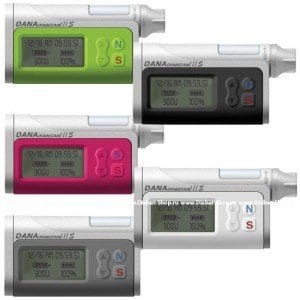 Made and assembled in Korea, the Sooil Dana Diabecare II Insulin Pump has been approved by the FDA. Distribution of the Diabecare insulin pump in the U.S. began in the year 2001. The makers of the Diabecare pump have created the world’s lightest insulin pump; the pump weighs only 1.8 ounces.
Made and assembled in Korea, the Sooil Dana Diabecare II Insulin Pump has been approved by the FDA. Distribution of the Diabecare insulin pump in the U.S. began in the year 2001. The makers of the Diabecare pump have created the world’s lightest insulin pump; the pump weighs only 1.8 ounces.
Although quite light, and smaller than a Paradigm pump, the Diabecare pump still has a reservoir that holds up to 300 units of insulin. Moreover, the small size of the pump did not require the pump makers to produce a tiny display screen. The Diabecare pump has a generous amount of space on its screen, although some users have indicated that they would prefer a screen with a better resolution.
By touching the proper icon, the pump wearer can call for display of a program menu on the screen. The screen also displays other important information, such as how much insulin remains in the reservoir. An alarm sounds if the insulin level falls below 20 units. The pump, the alarm and the screen are powered by a single 3.6 volt battery, which lasts two to three months.
The Diabecare pump delivers insulin into the implant every four minutes. The pump wearer can program the basal rate by altering the number of units dispensed during each insulin delivery. The controls have increments of 0.1 units.
The special features on the Diabecare allow the pump wearer to control various other parameters as well. The Diabecare pump has four different bolus programs: normal, default, pre-set and step programming. The pre-set program permits the quick coverage of standard meals.
The Diabecare pump can be set to send out a 30 minute melody reminder after a bolus insulin dose has been delivered. The pump also has a Guided Management pump lockout feature. Using that feature, the pump can be set for use by a child with diabetes.
The makers of the Diabecare pump advertise the low cost of their pump. It costs 20% less than any of the other pumps on the market. Still, those who are planning to purchase a Diabecare pump should know that it requires a Dana infusion set. Due to the presence of a reverse, luer lock connection between the infusion set and the hub, the Diabecare pump will not work with any infusion set other than that made by Dana.
While the holder of a Diabecare pump can not elect to use a different infusion set, he or she does have many choices during the purchase of the Diabecare pump. The pump can be programmed in one of six different languages: English, Spanish, Chinese, Korean, Hebrew and Turkish. The pump also comes in four different colors.
The Diabecare pump has dual microprocessors. Those microprocessors control the continuous cross-checking feature on the Diabecare pump. The pump keeps a close watch on the maximum bolus used, the maximum basal requested, the maximum daily total for insulin, the minimum level in the reservoir, the amount of power remaining in the battery and the possible appearance of a malfunction in the pump, or blockage in the line that carries the insulin.
The Diabecare pump stores the time and date for past settings requested by the pump wearer. The pump stores information on the last 50 boluses, the last 50 daily insulin totals, the last 50 primes and the last 12 alarms.
The screen on the Diabecare pump “sleeps” at night. That feature saves energy. It helps to prolong the lifetime of the battery that is being used to power the Diabecare pump.
The makers of the Diabecare pump did not think only about the power in the battery, they also gave thought to the durability of the pump motor. The Diabecare pump does not contain a motor that was made in Korea. The Korean factory at which the Diabecare pump is assembled puts a Swiss-built DC motor into each of its insulin pumps.